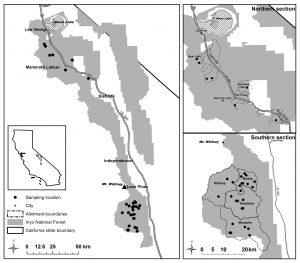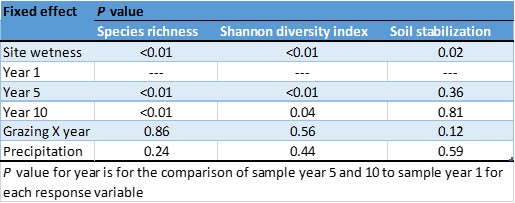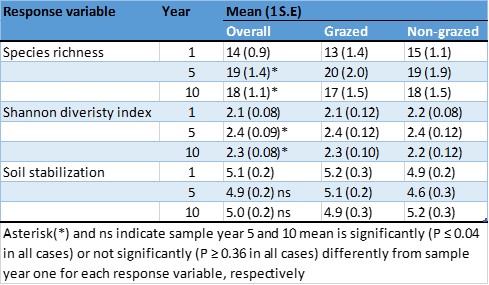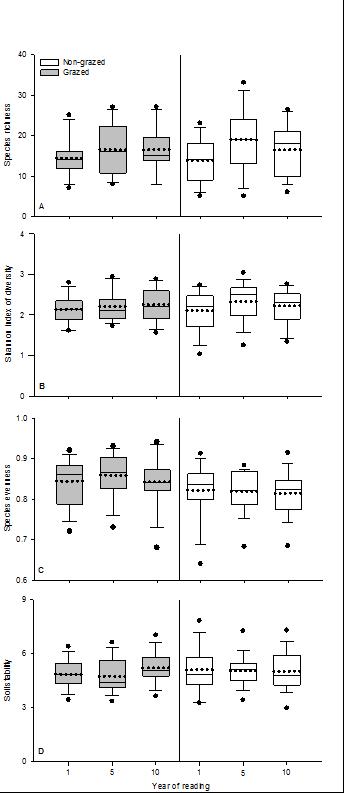Montane Meadow Plant Community Response to Livestock Grazing
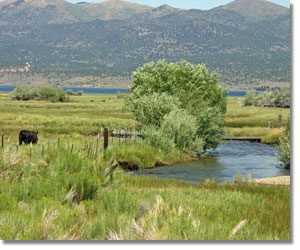 Introduction
Introduction
Livestock grazing on public lands is a controversial issue across the western United States, and policy-makers and managers are progressively charged with balancing diverse societal goals on these national lands. Montane meadows represent less than 10 % of the Sierra Nevada, but are critical to both summer cattle grazing and a variety of eco-system functions.
In the 1980s and 1990s, grazing was identified as a driving impediment to meadow restoration and aquatic species conservation, which lead to grazing suspension on two allotments in 2001. However, in a recent review George et al. (2011) found strong evidence that riparian and meadow resources can be protected through modern conservation grazing strategies controlling the intensity, timing, and spatial distribution of livestock grazing.
Examine long-term (10 years) meadow plant community responses to:
- Livestock grazing under modern riparian grazing utilization limits
- Suspension of livestock grazing
- Meadow site wetness and precipitation
Study Site
This study included 25 long-term meadow plant community monitoring sites located across four grazing allotments on the Kern plateau, Inyo National Forest in the Southeastern Sierra Nevada (Figure 1). These sites were grazed from April through October.
Grazing Management
Similar to most mountain public grazing lands throughout the western United States, the study allotments were historically grazed by domestic cattle and/or sheep during the growing season. Between 1991 and 2000, all allotments were grazed by cow-calf pairs (Table 1). Two allotments were excluded from grazing from 2001-2010 (N = 9 non-grazed study sites). Grazing continued on two allotments (N = 16 grazed study sites) from 2001-2010, subject to the following annual riparian grazing standards:
- restricted herbaceous biomass consumption;
- required minimum residual herbaceous heights;
- restricted browse on riparian willow species; and
- restricted livestock hoof damage to stream banks
Data Collection
This was a 10-year longitudinal survey of 25 plant community monitoring sites initially established between 1999 and 2001 at key meadow grazing areas across four grazing allotments. Transects were permanently established in a location representing the dominant plant community in each key meadow grazing area. Plant community composition based on relative species frequency was determined at each study site at sample years 1, 5, and 10. Species richness, soil stabilization score, meadow site wetness and annual precipitation mean were collected for each site.
Key Results
Trends in meadow plant species richness, diversity, and soil stabilization were not different between study sites excluded from grazing and sites grazed with riparian standards in place (Table 2). Regardless of grazing management, species richness and diversity increased and there was an overall shift in plant community composition between sample years 1 and 10 (Figure 2, Table 3). This shift was driven by increases in native, perennial forb species. Wetter meadows were typically dominated by perennial, deep rooted, clonal grass-like species, which decreased diversity but increased soil stability.
Our results indicate that livestock exclusion did not lead to greater rates of meadow plant community recovery compared to grazing management to achieve riparian grazing standards. Historical grazing practices that may have negatively affected meadow and riparian health are not comparable to the annual riparian grazing standards that have been implemented over the past two decades.
Table 2:
- Livestock grazing (grazed, non-grazed) by sample year (1,5,10) interaction was not a significant predictor of meadow plant species richness (P=0.86), diversity (P=0.56), or soil stabilization score (P=0.12). This indicates that trends observed for these plant community metrics were not significantly different between grazed and non-grazed study sites.
Table 3:
- Mean soil stabilization score was consistent across sample years 1,5, and 10 (P > 0.36)
- Species richness and diversity were significantly higher in both sample years 5 and 10 compared to sample year 1
- Analysis of both grazed and ungrazed sites revealed significant (P < 0.01) changes in overall plant community composition between years 1 and 10 of the study period
Figure 2: Box and whisker plots for species richness (A), diversity (B), evenness (C), and soil-substrate stabilization score (D) at sample year 1, 5, and 10 for study sites with grazing removed (non-grazed) and study sites grazed with riparian grazing standards. Solid circles are maximum and minimum observed values; whiskers are 5th and 95th percentiles; box are 25th and 75th percentiles; within each box solid lines are median values, and dotted lines are mean values.
Management Implications
Riparian centric grazing management to achieve limited riparian grazing is an important component of any strategy to conserve meadows on grazed national forest lands. Our findings support the adoption of a policy of riparian grazing utilization limits on these public grazing lands.
Further Reading

